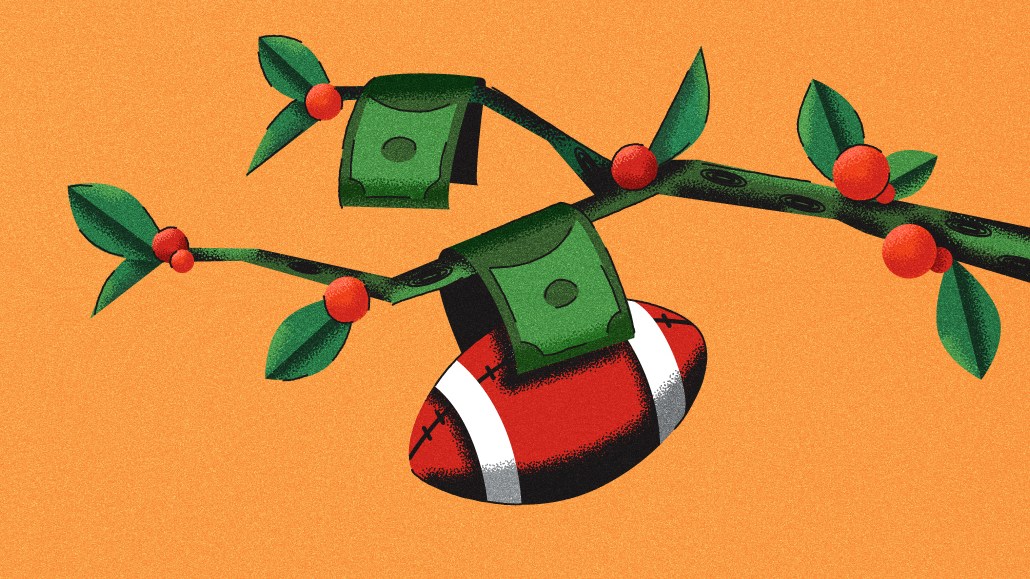JCPenney throws ad dollars at live sports to broaden its media mix as the industry waits for scripted TV to return

The Hollywood writer’s strike may have ended, but actors via the Sag-Aftra union, are still in negotiations. In the meantime, while the industry still waits for the return of scripted television shows, JCPenney began advertising around live sports.
“As we looked at the broader media landscape, customers, consumers, viewers continue to engage in live viewing of sports and sports events,” said Bill Cunningham, vp of marketing at JCPenney. “That was a big opportunity for us.”
Cunningham added that live sports wasn’t something the retailer had participated in its marketing and advertising history — at least not with traditional TV investments; the brand had a winning Super Bowl tweet a decade ago. But in an effort to maintain brand awareness and keep shopper attention, JCPenney reconsidered its media mix, per Cunningham. (It’s unclear how exactly JCPenney reallocated its budget as the retailer did not offer specifics.) The company has been on a mission, prioritizing digital and performance marketing as opposed to linear television and newspaper inserts.
Last month, the department store chain launched its so-called Make It Count campaign, introducing live sports into its media mix with a season-long sponsorship on Amazon Prime’s post-game for Thursday Night Football. There’s also a media buy into Major League Soccer, Cunningham said. While the Hollywood strikes influenced the retailer’s push into live sports advertising, it wasn’t the immediate decision maker, Cunningham added. The strikes did, however, compel JCPenney to reconsider its media mix to meet its brand awareness goals. (Three ways the Hollywood strikes were expected to impact the TV business here.)
Notably, the company filed for bankruptcy in 2020 and has since announced a multi-year, $1 billion reinvestment plan through fiscal year 2025. Post-bankruptcy, JCPenney has been focused on mass reach digitally while experimenting with channels, like live sports, and continuing to lean into influencers, and connected television. JCPenney’s future investments in live sports depend on how this one performs.
“We’re not pulling back. We’re leaning in,” Cunningham said of the company’s ad spend. He declined to provide specific figures. “We believe this is an opportunity for customers, new and old, to continue to see the value that JCPenney brings to them and their families.”
Last year, JCPenney spent more than $421 million on advertising, according to Vivvix, including paid social data from Pathmatics. That figure is up from the $315 million the company spent in 2021.
Marketers and agency executives have been closely watching the strike to understand how things will shake out. Hollywood writers have reached an agreement with gains in payment, size of show staffs and the use of AI in scripts. Meanwhile, actors remain in negotiations, asking for higher pay and AI usage in creative projects. In light of this, striking movie stars haven’t been allowed to promote studio films. While it has unfolded, advertisers have explored alternative broadcast channels, especially live sports, according to Satish Kumar, group media director at Two by Four ad agency.
Two by Four’s clients overall investment into live sports has increased significantly year-over-year, Kumar added. Last year, it represented about 10% of total television and connected television spend for the agency’s clients; this year, that figure increased to 35%.
“This cache is the trend that will continue to expand marketers’ desire to be part of the sports franchises— it’s not just the Hollywood strike,” Kumar said in an email.
Advertiser interest has been mounting in the sports arena. Formula One has seen a surge of interest in the U.S., capturing the attention of publishers, and marketers like Moneygram, Red Bull and Hilton Grand Vacations. Women’s sports marketing has seen a boom, breaking viewership records and spurring new agency services. Meanwhile, there continues to be more ways to buy media in live sports, including through streaming and programmatic buys.
All said, there are more opportunities for marketers to get into live sports advertising than before. So while the strike may have added fuel to the flames, the fire was already burning, advertising executives say. “It’s the last bastion of live, family, engaged audience,” said Carrie Drinkwater, chief investment officer at Mediahub media agency.
That’s not to say that there should be a gold rush into live sports marketing, said Adam Bavaro, integrated strategy lead at Gale, a business agency. Live sports advertising can boost brand awareness, but inventory can be pricey, he said. The Super Bowl is a prime example. This year’s big game was $7 million for a 30-second spot. (Here’s what that $7 million could purchase in digital media this year.)
“If you’re a big player, and you see the opportunity within live sports, then you’re going to invest more money to be in front of that,” he said. “It’s really: How much money do you have and is it the right place to reach your audience?”
Beyond live sports, the retailer is engaging in podcasts, streaming audio and ad spots on Vevo, a music video network.
“Again, making sure we’re in the spaces where the consumers are, engaging and living out their real moments in real life.,” said Cunningham, JCPenney’s vp of marketing. “That’s in the core of our media plan still today because we see great opportunities in being in the space where consumers are listening to music in their everyday lives.”
More in Marketing

Best Buy, Lowe’s chief marketing officers explain why they launched new influencer programs
CMOs launched these new programs in response to the growing importance of influencers in recommending products.

Agencies create specialist units to help marketers’ solve for AI search gatekeepers
Wpromote, Kepler and Jellyfish practices aim to illuminate impact of black box LLMs’ understanding of brands search and social efforts.

What AI startup Cluely gets — and ad tech forgets — about attention
Cluely launched a narrative before it launched a tool. And somehow, it’s working.








